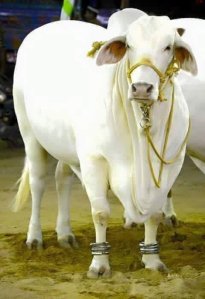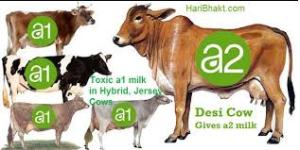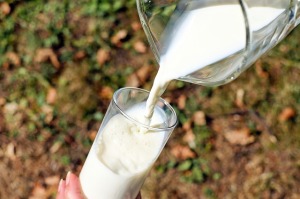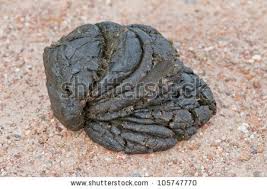INTRODUCTION: Sanatana dharma described cow as sacred animal and mentioned as
Gomata. People worshipped and valued cow as the mother. All the devatas and Gods
reside in cow.
India has several breeds of cows .we can easily identify the Indian cow with its bump,
horns,and the skin under the neck which is loosely falls in folds.It has high immunity
levels.

Lord Krishna showed special affection towards cows. He gave atmost care to the cows. In
the childhood of Krishna his mother Yashoda used to apply Gomutra to the forehead so
that he will be saved from all the demons.She believed that by protecting cow she will
receive wealth,health and prosperity and can get rid of all negative energies. As a cowherd
Krishna was born and bought up . He used to play along with other friends on the sand
where cows walked and he was proud to appear with Godhuli. He made cow deities and
offered prayers to them.At the end of his avatar Krishna told to his son Uddava that
worshipping of cow is equal to his pooja. Also Krishna said Uddava that he got the power
to kill demons only by worshipping cows. By worshipping cows krishna showed direction
to the human kind and also explained how important it is to the future generations.
The two names of Krishna
Gopala: who is the protector of cows and
Govinda: Who brings satisfaction to the cows
shows his love for cows.
In the 11th canto of Shrimat Bhagavatam Krishna told that by offering cow, grass and
other suitable grains he can be worshipped. By consuming cow milk one can develope
satvaguna.Bhagavatgeeta tells us by drinking cow milk one can have the divine
conciousness and divine energy. protection of cow not only improves the life of cow, but it
will preserve nature by conserving the quality of soil, water, and air and improves human
life by its products.
India is the largest producer of milk. Indian cow milk contains A2 protein.It has superior
quality to the A1 protein in western breeds and cross breedings.
with the indiscriminate usage of chemicals and pesticides the soil and water quality
reduced which inturn deteriating the health of living beings .usage of cow urine and cow
dung in the agriculture are the best solutions for this problem.
Now a days many farms are using cow dung as a manure . By mixing cow urine with neem
leaves can be sprayed on crops and it is effective pest controller.Both are environmental
friendly.
In India, many societies ,temples and individuals are showing interest to establish
goshalas. These are producing medicines, cow dung cakes,Vibhuti for religious occations
cosmetics, repellants, disinfectants for personal life.
———————————————————————————————————-
Cow milk:
Panchagavya: The five products which are obtained from cow – Milk, Curd, Ghee, Urine
and dung are called Panchagavyas.
Difference Between A1 & A2 Milk :

The two types of Milk are A1 & A2 . The milk
from western cow breeds is A1 type and the milk from Indian cow breeds is A2 type.
Milk contains proteins. In proteins there are three types of caseins. Alpha casein, beta
casein and gamma casein. 209 amino acids combine to form beta casein. In beta casein if
67% is histidine it is A1 type milk if 67% is proline it is A2 type milk. When we
consume A1 type milk 7 amino acids break to form BCM_7 ,(Beta casein morphine) as the
molecules are loosely binded. If it reaches brain 5 different types of diseases occure.
1.Heart diseases, Arteries blockage
2. Blood pressure
3. Autism
4. Sudden infant death syndrome
5. Diabetes type1
While in A2 type milk because of proline it is rich in
1. Amino three fatty acids- improves fitness&vitality
2. Cerebrosides- helps in brain development
3. Conjugate linoleic acid(CLA)- useful in fighting the diseases like cancer, diabetes, heart
attack. It is anti oxidant.
A2 type cow’s milk is next to mother’s milk.

USES OF COW MILK:
1. Improves intelligence and strength
2. Assists in easy movement of intestines
3. Increases life span
4. Useful in treating diseases related to urinary system
5. Nourishes the body tissues
6. To relieve burning sensation and to relieve oral ulcers cow milk is gargled
7. It is rich in calcium,vitaminD
8. Increases breast milk in the feeding mother.
WHO SHOD NOT DRINK:
1. Who are obese
2. Who have low digestion power
3. Who are allergic to milk
INCOMPATABILITY WITH OTHER SUBSTANCES:
1. Milk along with sour substances is not recommended
2. After consuming green leafy vegetables and radish drinking milk should be avoided
———————————————————————————————————-
Cow curd:
PREPARATION: Curd/Yogurt is made by boiling milk and when boiled milk cools down
to lukewarm temperature little curd is added in room temperature. During fermentation
process bacteria produce lactic acid from the lactose of milk and give thick texture
forming curd or yogurt or dahi. It is called Dadhi in sanskrit.
There are two types of curds.
1.Sweet curd
2.Sour curd
It depends upon
1.How old is the curd-older the curd, more the sourness
2.Amount of curd added to the milk during making of curd.
Sweet curd: It is thick in nature sweet in taste. It increases body fat. It is cool in nature.
Sour curd: It is hot in nature, increases fire in the body.
Uses of cow curd/Yogurt
1. Cow milk of A2 variant curd possesses a unique quality by which it absorbs water from
intestines.with this property it is used to treat diarrhoea and dysentery
2. It is sleep inducing
3. It increases blood and reproductive fluids in the body
4. It is rich source of calcium and vitamin D so best source to prevent osteoporosis
5. It prevents from the ulcer of stomach and decreases the risk of stomach cancer.
6. It lowers the risk of colon cancer as it contains the lactobacteria
7. when small amount of rice with sweet curd is taken on empty stomach migrain headache will be reduced
8. Due to its lactic acid content when applied on face increases complexion
9. Applying the sour curd on the face and neck for 15 minutes removes the acne and dead skin cells and makes it fair
10. Applying the mixure of black pepper powder and curd for twice a week removes dandruff
Disadvantages:
1. Excess amount of curd/yogurt intake may reduce appetite
2. Excess amount may lead to weight gain
3. Excess intake may cause heart problems because of cholesterol content
It is recommended to take 250ml of curd during day meal.
Not recommended:
1. Curd at night is not good
2. Curds along with palm date is not good
3. Heating of curd should be avoided it loses its properties due to heating
4. Curd is heat producing and has heat effect on the body and it is good in winter season to
keep body heat and it is not good in other seasons.
5. It is best to avoid curd , people with obesity , bleeding disorders and inflammatory
conditions.
———————————————————————————————————-
Cow ghee:
INTRODUCTION: Ghee is made from butter and impurities are removed from it. cow
ghee is most sacred and physically health benefiting substance. For thousands of years in
Ayurveda cow ghee mixed with other herbs is used as medicine. It does not spoil easily. A
person who isallergic to dairy products need not be allergic to ghee. The colour of cow
ghee is golden due to the presence of carotenoids.
USES OF COW GHEE:
1. Ghee is slightly hot in nature, because of its hotness, it helps to improve digestion strength.
2.To have clear eye sight 1 or 2 drops of ghee can be applied (only in case of strained eyes)
3.To have good immunity , memory and longivity ghee is useful.
4. People having dry skin can apply ghee as a moisturiser .
5. Regular consumption of ghee in diet can put up weight for those with lean bodies.
6. Ghee is used for application over wounds and burns to reduce heat.
7. Ghee is applied over lips to heal the cracked lips and heel cracks .
8. Ghee is used in spiritual practices-in homas.1 kg of cow ghee makes a ton the oxygen in reaching troposphere.
9. If ghee is applied to the inner walls of nostrill, it helps to avoid dust allergy.
10. It detoxifies body.
11. Ghee is best for lubrication of joints.

SITUATIONS WHERE GHEE SHOULD NOT BE TAKEN:
1. Person suffering from Jaundice, hepatitis, cardiac, renal problems
2. During fever
3. persons suffering from cold and cough
4. Excess ghee can cause diarrhoea and indigestion and may lead to weight gain.
It is always better to take ghee from churned curd than prepared from cream of milk.
As the ghee from cream of milk has high cholesterol and not easily digestable.
Daily one table spoon of ghee is preferred in diet for best results. It is traditionally
considered that, the older ghee , the better its healing qualities.
———————————————————————————————————-
Cow urine:
Introduction:
In traditional Indian medicine, Ayurveda, cow urine is used for therapeutic purpose. It is
also used in Vastu sastra for purification purpose. Urine of a pregnant cow is considered
special and it contains special minerals and hormones.
Composition: Cow urine is 95% water, 2.5% urea and 2.5% a mixure of minerals,
hormones, salts and enzymes. It also contains vitamins A,B,C,D,E, sodium, nitrogen,
sulphure, minerals, iron, silicon, manganese, chlorine, magnesium, citric, succinic,
calciumsalts, phosphate, lactose, carbolic acid enzymes.
Any deficiency or excess of these substances inside the body causes disorders. cow urine
contains all these substances. so consumption of cow
urine restores the balance of these substances thus curing the diseases.
Uses of cow urine:
1. It increases the phagocytic activity of macrophages and helps to cure bacterial infections.
2. It is effective antiseptic, disinfectant, antibiotic and germicide.
3. It is useful in the treatment of migraine headache, cough, thyroid.
4. With the presence of high concentrated nitrogen acts as a renal stimulant.
5. Presence of copper and calcium acts as anti obesity agent and helps for better bone strength.
6. Aurum hydroxide and copper acts as detoxifying agents.
7. Useful in constipation .
8. Useful in skin diseases like vitiligo (leukoderma) treatment.
9. In case of sore throat cow urine is gargled.
10. In intestinal obstruction cow urine is used as enema
11. In liver disorders and cancer patients by consulting Ayurvedic doctors, dosage is recommended.
12. It is effective pest controller when used along with other herbs.
13. It can be used as a biofertiliser to increase the crop production.
14. Cow urine is used in purification rituals-in yagnas,homas.
Cow urine therapy is cleansing and detoxifying it is not for nourishment in nature. only by
consulting Ayurvedic doctor it should be consumed.
It is always advisable to take distilled Indian cow urine. Since boiling is involved ,cow
urine distillate will be free from microbes. It is better to
take 3 to 4 drops of cow urine one or two times a day consulting physician.
Cow urine along with milk also can be taken. one tablespoon of Indian cow urine along
with half a cup of milk is better to have.
The first and last part of the cow urine is discarded and the middle part is collected during
dawn.
Precautions:
1. If the cow is infected urine may be infected.
2. It is not advisable to store fresh cow urine for more than 1 hour.
3. By consulting Ayurvedic doctor it is better to take cow urine only for prescribed time
period only otherwise gastric trouble may occure.
Who should not use:
1. Who are suffering from male infertility
2. Those who are fatigue
3. who are very lean
4. children below the age of 10 years
Side effects:
1 .consumption of cow urine may cause diarrhe
2. It may cause itching on the body while externally applying
3. It may cause fever.
4. It may cause soreness of the shoulder.
Side effects of Jersey cow urine:
1. A study on mice found that high dosages of Jersey cow urine cause death.
2. Repeated administration of Jersey cow urine in dogs showed
hypertension,tachypnea(abnormally rapid breathing)
3. Madcow disease may be passed to humans when eaten infected flesh.
A study found prions (infectious agents composed entirely of a protein material) in
considerable amount in the urine of Jersey cow suffering from mad cow disease.
———————————————————————————————————
Cow Dung:
Cow dung is the waste product comes through cow’s gut. Cow dung gas contains methane
55 to 65% , carbondioxide 30 to 35% hydrogen, nitrogen and other gases.
Methane is the most powerful green house gas which is responsible for stratospheric
ozone layer depletion and causing globle warming.
When the cow dung spread on the farms, before methane gas escapes in to
atmosphere , if it is put in the digester it can be converted in to biogas. This is the
principle involved in the production of biogas.
Why cow dung:
The chief constituents of organic matter are nitrogen, phosphorus and potash. The soil
absorbs nitrogen from the atmosphere and makes it available to the living beings in the
form of fodder and grain . The living beings derive energy from it and nitrogen is returned
to the soil in the form of manure, compost etc. thus completing the nitrogen cycle. If this
cycle is disturbed results will be adverse to the living being.

Cow dung has a great role in the crop growth as a manure as it contains humic
compounds and fertilizing bio meterials. It enhances the quality of the soil and works as a
soil conditioner. Plants absorb phosphates from the soil, which is returned to it through
animal dung, decayed plants and their ashes. Cow urine is rich in nitrogen.
The dung produced by a cow in one day depends upon the size, type of the animal. Dairy
cows produces the most at 62 kgs per day while calf produce 12 kg. The average cow
produces around 29 kgs of dung in a day. They also urinate around 13 lts of urine in a day.
A dairy cow produces around 400 lts of methane in a day.
High yielding milk producing cow requires about 40-45 kgs of fodder(dry&wet) and can
produce 22-28 kilos of fresh dung daily.
To produce 1 kg of bio gas appr.22 kgs of dung is required.
Working principle of Biogas plant:

Cow dung and water is mixed in the mixing tank. This slurry enters the digester tank
through inlet chamber. This slurry is left for two months for fermentation. Anaerobic
micro organisms are responsible for fermentation which produces bio gas. It produces
large pressure on the slurry and forced it to go in the over flow chamber. The bio gas is
taken out from the dome through a pipe and used for various purposes. The residue is
used as manure to the plants as it is rich in nitrogen and phosphorous.
Uses of cow dung:
1.The mixure of cow dung, vegetable wastes and some species of earth worms under
humidity conditions when put for 15 to 20 days makes vermi compost.
2. When cow dung is dried, sterilized and mixed with other herbs it is used as a skin care
cake.
3. By using half burnt cow dung cake and other aromatic components tooth powers are
prepared.
4. When cow dung is mixed with straw dust it can be used as a building material.
5. Cow dung is a good insulater when it applied to the outer walls it keeps 8 to 10 degrees
temperature low compared to outer temperature.
6. It is a raw material for paper making.
7. It is a rich fertilizer.
8. It can protect from radiation.
9. Cow dung can be used to produce small amout of electricity, by connecting copper and
zinc plates to it. Yet research work is required on this .
10. It has anti bacterial properties.
11. It is best disinfectant.
12. It is an excellent mood enhancing agent. It contains a bacteria mycobacterium vaccae
which activates some of the brain neurons to produce serotonin-a neuro transmitter ,
which is responsible for happiness in a person.
13. with the production and usage of biogas new local jobs can be created and it is a green
energy.
14. The slurry from the digester tank can be used as food supplement in the fish ponds.
15. Dried cow dung is odourless acts as a mosquito repellent.
Side effects:
1. If the cow dung is used as a cooking fuel for long term respiratory problems may occur.
2. Fresh cow dung can not be used as manure as it contains bacteria such as E coli.
3. when it is composted it becomes nutrient rich. If it is not properly composted it may
harm plants and some strange patterns may grow.
———————————————————————————————————-
